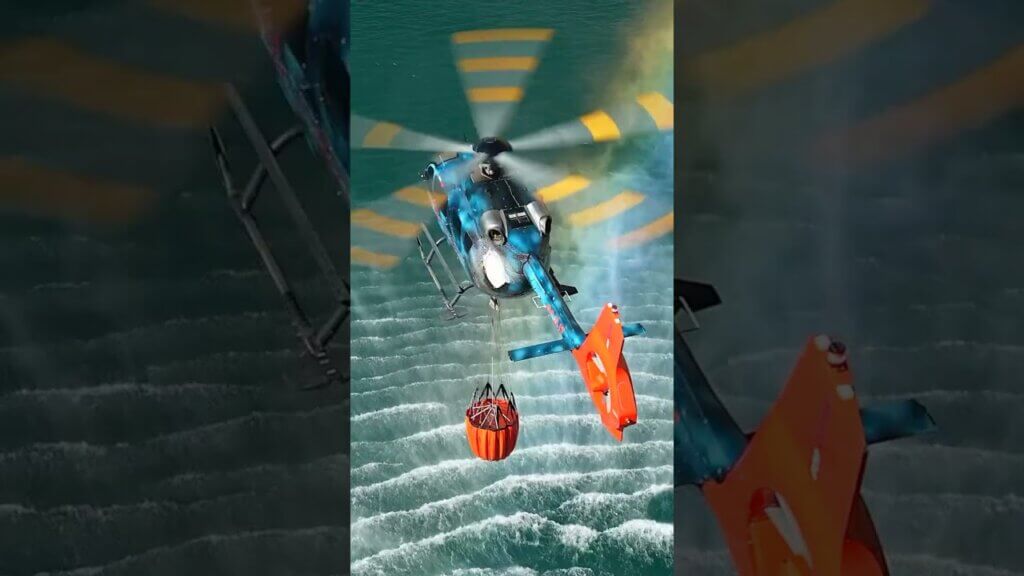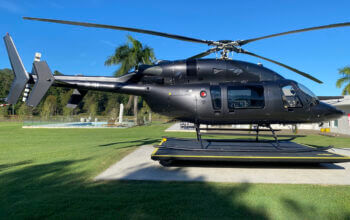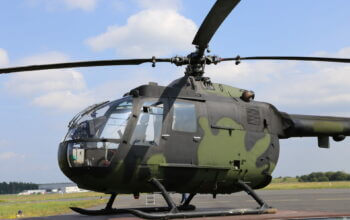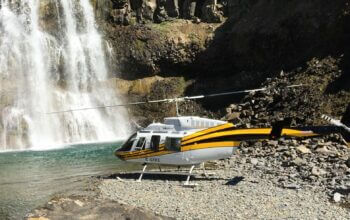Swiss startup Dufour Aerospace has shared new images of its tilt-wing Aero3 eVTOL concept, which now has additional propellers on its wing and a redesigned tail.

The piloted hybrid-electric aircraft is being developed to compete with today’s helicopters for missions including passenger transport and emergency medical services. Capable of seating up to eight people, it is targeting a cruise speed of 350 kilometers per hour (around 215 miles per hour), a range of up to 1,020 km (630 miles), and a useful load of 750 kilograms (1,650 pounds). That useful load figure includes fuel for its hybrid propulsion system, the details of which have yet to be confirmed.
Earlier conceptual images of the Aero3 showed a total of four propellers across its tilting wing, similar to the technology demonstrator that completed initial flight testing last year. The new design features six propellers distributed across the main wing, increasing redundancy, plus two smaller propellers on the tail.

Dufour announced last year that it had received a grant from the Swiss innovation agency Innosuisse to conduct wind tunnel testing for the Aero3. According to Dufour co-founder and chief technology officer Jasmine Kent, “Our test flights with a large-scale demonstrator and the wind tunnel tests have clearly confirmed the exceptional performance and versatility of the tilt-wing design. The results met our high expectations.”
She added that the tilt-wing concept has already been demonstrated in projects such as the Canadair CL-84, “so there are fewer risks than with other VTOL concepts.”
According to Dufour chief commercial officer Sascha Hardegger, Dufour now expects to build its first full-scale prototype next year and commence flight testing toward the end of 2022. The company is working toward certification of the Aero3 by the end of 2025.

In the meantime, Dufour also expects to commercialize a smaller drone version of the aircraft for applications including logistics, inspection, monitoring, mapping, and public safety. The company said it will publish the specifications for this “Aero2” model at a later date.
Earlier this year, Dufour announced it had secured an undisclosed amount of additional funding in a round led by the early stage venture fund session.vc. Hardegger told eVTOL.com that while the company is preparing its next financing round, it is too early to share further details.









Tilting tail rotors could add more elegance and improve cruising flight. Photos show traditional propellers mounted everywhere. Application of new generation, enhanced speed range propellers could increase efficiency and range. Design is attractive with an air of classic reliability – a bonus for future passengers.
Congrats on the redesigned tail. It looks familiar somehow. 😉
I have always thought that this design would solve a number of complications with VTOL aircraft but this is NOT a new design (except for the power source). This same design was proven in the 1950’s by the AirForce when they built and flew a two-engine version: the VERTOL VZ-2 Model 76. I am not getting down on this aircraft however, I hope it succeeds!
Absolutely correct. The design is derived from the CL-84 aircraft. It has the same aerodynamic concept – a well researched and proven by many dozen pilots flying it. And even in modern times with electronic control systems the fact that it is an inherently stable aircraft that can be flown manually (or today only requires rate control system) reduces massively the complexity.
Don’t forget the Chance Vought XC-142 of the 60’s that was a good R&D program but never made it to production. High disc loading propellers and a problematic tail rotor that with a loss in hover caused a fatal crash.
Also not to knock the design but be aware of the pitfalls from past complex tilt wing designs.
Quartering winds created issues in hover and low speed flight.
Yes. As well the XC-142 was a big inspiration for us. One of the advantages of modern electric propulsion systems is that it can made redundant and reduce failure risk of one single component – thus 2 independent propeller and motor systems at the tail as well.
Regarding tiltwing complexity: The opposite is true: instead of having multi tilt systems that all cause complexity we only have one tilt wing system – at the center of the aircraft and not at the edges of a wing or in front/back of the wing. This allows for massive less structural complexity in the wing design itself.
Regarding redundancy. It si a missconception that a tiltwing has a single point of failure. A hinge and tilting systems can be designed multi redundant and multi load path capable. This is as well not a new technology. It is derived from the Airliner design. It is the same design principle as a flap mechanism on an airliner – they need as well to be multi redundant, multi loadpath and structural damage tolerant. Proven in many billions of flight hours.
Side winds is another missconception: As the wing is fully emerged in the propwash, the exposure to side winds is very small. All CL84 pilots reported great behavior in side and gust winds – kinda logic as the propwash is a storm compared to the side winds. The CL84 has landed on aircraft carriers in strong winds with pilots land first time on aircraft carriers. Same behaviour has our eVTOL demonstrator – we flew it in all wind conditions -gusty up to 25kts from all directions and it has excellent controlability in all axes.
And finally controllability: Yaw control is beyond every other aircraft existing (again propwash at the ailerons), pitch and roll authority as well. And the laminar flow around the wing does have a huge effect on the power as soon as you just slightly tilt the wing it has additional huge power reserves – exactly what a mountain rescue pilot like me wants to have at limit power and gusty wind conditions. 🙂
Is there not a plane that looks more like a glider? So less energy is needed. Solar panels perhaps? It’ll happen no doubt in the near future.